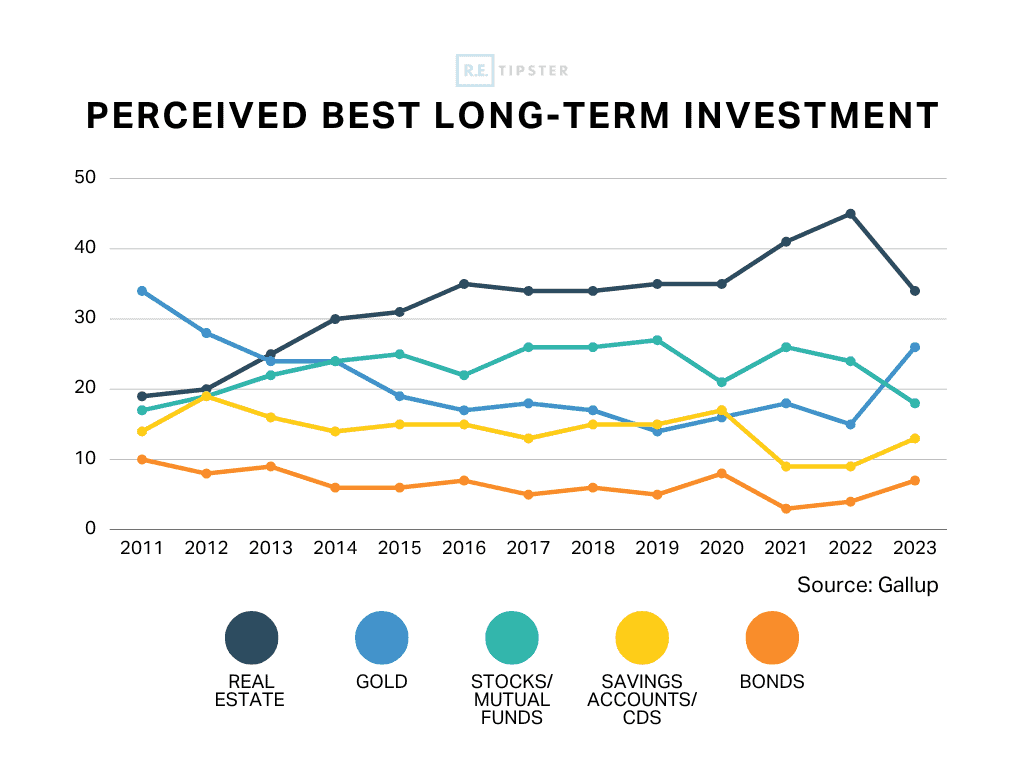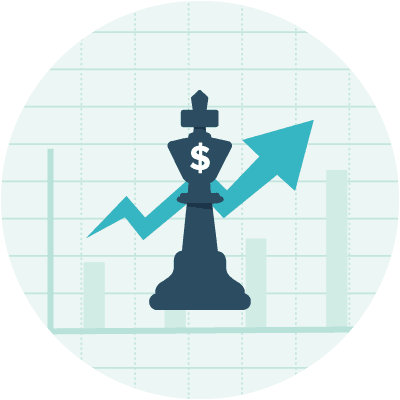What Is Passive Income?
REtipster does not provide tax, investment, or financial advice. Always seek the help of a licensed financial professional before taking action.
Shortcuts
- Passive income is money earned with little daily effort, unlike active income, which requires daily or consistent activity.
- Passive income is key to financial independence, the flexibility and freedom to pursue personal interests, and wealth accumulation.
- There are many ways to generate passive income, one of the most common being investing in real estate due to the potential appreciation of property.
- Other strategies for passive income include dividend or stock investing, lending directly to borrowers, creating or selling digital products, running an online business, or saving in high-interest savings accounts or certificates of deposit.
- Passive income is not a get-rich-quick scheme, as setting up a passive income stream requires time, money, and effort.
How Passive Income Works
Passive income is income derived from a business or investment in which you don’t actively participate. Unlike active income, which typically requires ongoing time and effort, passive income is generated through assets, investments, or business ventures that need little to no direct involvement.
Passive income can come from various sources, including investments, real estate, business ventures, and online assets. The key characteristic of passive income is that it continues to generate revenue even if the individual is not directly involved in the day-to-day operations.
Passive Income vs. Active Income
Passive income can be contrasted with active income, which is earned through direct employment or actively providing services.
Active income is directly tied to the number of hours worked or services rendered. In contrast, passive income is generated independently of the hours worked and can continue to flow even when the earner is not actively working.
For instance, if you invest in stocks of a profitable company, you could receive dividends, essentially a share of the company’s profit. This is passive income because, after the initial effort of choosing and buying the stock, no daily action is required on your part. Similarly, interest from bank savings or bonds accumulates without active engagement.
Note that active and passive incomes aren’t mutually exclusive[1]. You can have both to live the life you want, although passive income is more desirable because less work is involved.
Benefits of Passive Income
Some key benefits of passive income include:
- Financial independence: Passive income allows individuals to diversify their income streams and reduce their reliance on a single source of income. This can provide a greater sense of financial security and freedom.
- Flexibility: Passive income provides the opportunity to earn money while having the flexibility to pursue other interests and spend time with family and friends.
- Wealth accumulation: Passive income can contribute to long-term wealth accumulation by generating income that can be reinvested or saved for future financial goals.
- Retirement planning: Establishing passive income streams can be an effective way to prepare for retirement, ensuring a steady income flow even after leaving the traditional workforce. It’s a core component of the FIRE (financial independence, retire early) movement[2] and estate planning.
Strategies for Generating Passive Income
There are many strategies to generate passive income.
Real Estate
Real estate investment is a popular and widely recognized passive income method. It can provide individuals with a steady stream of passive income while offering the potential for long-term wealth creation.
It also consistently ranks high among Americans in terms of perceived income:

Source: “Real Estate’s Lead as Best Investment Shrinks; Gold Rises”
Some common strategies in real estate include:
- Flipping: Also called a “fix-and-flip,” flipping involves buying properties at a discount and then selling them at a markup, usually by renovating or fixing the property.
- Rental properties: Owning and renting out residential or commercial properties can provide a steady income stream from rental fees paid by tenants. The income you generate may vary across states. For instance, New York State might see higher annual income from rental property investors than other states[3].
- Real estate crowdfunding: Crowdfunding platforms allow individuals to pool their resources and invest in real estate projects. Investors can choose to invest in specific properties or portfolios of properties, diversifying their investments across different locations and types of real estate. Some platforms also allow non-accredited investors to start investing, sometimes for as low as $10[4].
- Real Estate Investment Trusts (REITs): Investing in REITs allows individuals to earn income through real estate without the need to own or manage properties directly. REITs are companies that own, operate, or finance income-generating real estate. Investors can buy shares in REITs, which provide them exposure to real estate assets and a percentage of the rental income the properties generate.
- Land investing: Land can generate income from various purposes, such as leasing land to farmers, developing it for recreation, or subdividing it into smaller lots and selling those lots individually. Other ways include leasing vacant or raw land to utility companies for renewable energy, such as solar or wind farms, or even cell towers or data centers.
- Buy-and-hold: This strategy involves purchasing properties to hold them for an extended period, earning rental income, and benefiting from property appreciation over time. Investors can focus on residential properties, commercial properties, or a combination of both. Regardless of the choice, the success of this strategy hinges on the right rental market and the rate of property appreciation in that area[5].
- Airbnb rentals: Renting out properties on platforms like Airbnb can be a lucrative way to generate passive income, particularly in high-demand tourist areas[6]. An Airbnb arbitrage is an alternative if you don’t own your own house and want to sublease it to a tourist.
Advantages of Real Estate Investment as Passive Income
- Cash flow: Rental income from real estate properties can provide a consistent cash flow, especially in areas with high demand and rental rates. This income can cover expenses and generate additional profit.
- Property appreciation: Real estate investments have the potential for property value appreciation over time. As the property value increases, investors can benefit from capital gains when they sell the property.
- Tax benefits: Real estate investors can take advantage of tax benefits[7], such as depreciation deductions, mortgage interest deductions, and property tax deductions. These deductions can offset the tax liability from rental income.
- Portfolio diversification: Real estate investments offer diversification benefits by adding an asset class independent of traditional stocks and bonds. This diversification can reduce portfolio risk and increase overall stability.
Dividend Investing
Dividend investing involves purchasing stocks that pay regular dividends to shareholders. This can provide a consistent stream of passive income. Dividends are typically paid out in cash, although some companies may offer dividends in the form of additional shares or other forms of value[8].
Some examples of dividend investing include:
- Dividend stocks: Investing in companies with a history of paying dividends can provide a reliable income stream.
- Dividend ETFs: Exchange-traded funds (ETFs) that focus on dividend-paying stocks offer diversification and convenience for passive investors.
- Index funds: Investing in low-cost index funds can provide broad market exposure and potential long-term growth.
That said, investors should consider the yield (i.e., the measure of the annual dividend payment relative to the stock price) before committing to an investment. Yield is a metric that generally indicates investors’ potential return on investment. Note that excessively high yields may mean an unsustainable dividend or underlying issues with the company[9].
In addition to the current dividend yield, investors should also consider a company’s historical dividend growth rate. Companies that consistently increase their dividends over time may provide investors a growing income stream and potential capital appreciation.
Finally, dividend income is typically taxable, with the tax rate depending on the dividend type[10]. Investors should be aware of the tax implications of dividend investing and consider factors such as tax rates and tax-efficient investment vehicles.
Peer-to-Peer Lending
Peer-to-peer (P2P) lending platforms allow individuals to lend money to others without an intermediary, like a bank. Once a loan is funded, lenders start earning interest on their investment as borrowers make repayments.
This income is considered passive because lenders do not have to actively manage the loan or be involved in the day-to-day operations of the borrower’s business.
Benefits of P2P lending include:
- Higher returns: Peer-to-peer lending often offers higher interest rates[11] than traditional savings accounts or fixed-income investments, potentially leading to higher passive income.
- Diversification: Lenders can diversify their investment across multiple loans, spreading the risk and reducing the impact of any defaults.
- Control and transparency: Lenders have control over their investment decisions and can review detailed borrower information before making lending decisions. P2P platforms provide transparency by offering loan performance data and borrower creditworthiness metrics.
Creating Digital Products or Online Businesses
Building and selling digital products[12], such as e-books, online courses, or software, can be a profitable way to generate passive income.
Digital products are intangible goods that can be created and distributed online. They can take various forms, such as e-books, software applications, music, graphics, templates, and more. These products can be produced once and sold repeatedly, allowing for potential passive income generation. An online course like REtipster’s Land Investing Masterclass is also an example.
On the other hand, an online business involves offering goods or services through an online platform. It can take various forms, such as e-commerce stores, digital agencies, consulting services, software-as-a-service (SaaS) platforms, and more. Online businesses can generate passive income if designed and executed effectively.
Affiliate marketing or dropshipping[13] are other examples of online businesses that can also provide opportunities for passive income. They’re remarkable as they involve no exchange of products or services in the traditional manner; for example, dropshipping allows a business owner to take orders even without inventory or stock on hand.
High-Yield Savings Accounts and CDs
While interest rates vary, keeping funds in high-yield savings accounts or certificates of deposit (CDs) can generate passive income through interest earnings.
A high-yield savings account is a type of savings account that typically offers a higher interest rate than traditional savings accounts. Online banks or credit unions usually offer these accounts, allowing individuals to earn interest on their savings while keeping their money easily accessible. Some institutions offer rates as high as 10 times the regular rates of savings accounts[14].
Meanwhile, a certificate of deposit is a financial product many banks and credit unions offer that allows individuals to deposit money for a fixed period at a fixed interest rate. CDs typically have higher interest rates than savings accounts but require locking in your funds for the duration of the term, which can be anywhere from 30 days to five years[15].
Researching and comparing different financial institutions can help find the best rates for these products.
Frequently Asked Questions: Passive Income
1. Is passive income truly “passive”?
While passive income is often referred to as “passive,” it usually requires some initial effort and a degree of upkeep. Establishing a passive income stream, such as a rental property or an online business, typically involves upfront work, such as property acquisition, setting up systems, or creating content.
Additionally, passive income streams may require periodic monitoring, updates, and adjustments to ensure they continue to generate income. While it’s not as involved as active income, you still need to put in some work from time to time to keep the income stream healthy.
2. How much money can I make from passive income?
The amount of money you can make from passive income varies depending on the source and your level of investment.
Some passive income streams, such as rental properties or successful online businesses, have the potential to generate significant income. How much depends on factors such as market conditions, investment strategies, and the level of effort put into establishing and maintaining the income stream.
Note that passive income is not guaranteed to make you rich[16]. Establishing a successful income stream requires upfront effort, time, and investment; for example, sweat equity is one way to maximize a flip. In addition, research, planning, and ongoing monitoring are essential to maximize the income you generate passively.
3. Can anyone earn passive income?
Yes, anyone can earn passive income, but it will depend on individual skills, resources, and willingness to invest time and effort. Your likelihood of success increases when you choose an income stream that aligns with your interests, skills, and resources to increase the likelihood of success.
Remember that passive income is not a get-rich-quick scheme but a long-term strategy for financial stability and wealth accumulation. It requires patience, perseverance, and a proactive approach to build and maintain successful income streams.
Sources
- Passive Income vs Active Income. (n.d.) Wallstreetmojo.Retrieved from https://www.wallstreetmojo.com/passive-income-vs-active-income/
- Gauthier, M. (2023, August 20.) How to generate passive income and live off it, FIRE style. Hardbacon. Retrieved from https://hardbacon.ca/en/financial-independence/how-to-generate-passive-income-and-live-off-it-fire-style/
- Yale, A. (2023, May 11.) Real Estate Investor Salary. The Motley Fool. Retrieved from https://www.fool.com/investing/stock-market/market-sectors/real-estate-investing/basics/how-much-real-estate-investors-make/
- Gobler, E. (2023, May 18.) Real Estate Crowdfunding: Should I Consider It? The Balance. Retrieved from https://www.thebalancemoney.com/real-estate-crowdfunding-should-i-consider-it-5196453
- Sopielnikow, K. (n.d.) A Beginner’s Guide To Buy & Hold Real Estate. FortuneBuilders. Retrieved from https://www.fortunebuilders.com/a-beginners-guide-to-buy-hold-real-estate/
- Davis, K. (2023, April 10.) Airbnb Investment Properties: What You Need To Know. Quicken Loans. Retrieved from https://www.quickenloans.com/learn/airbnb-investment
- Gariepy, L. (2023, January 12.) Tax Benefits Of Real Estate Investing: Top 6 Breaks And Deductions. Rocket Mortgage. Retrieved from https://www.rocketmortgage.com/learn/tax-benefits-of-real-estate-investing
- Kuepper, J. (n.d.) Cash vs. Stock Dividends: Know the Implications. Dividend.com. Retrieved from https://www.dividend.com/how-to-invest/cash-vs-stock-dividends-know-the-implications/
- Stalter, K. (2023, July 12.) Understanding the Hidden Pitfalls of High-Yield Investments. Money – U.S. News. Retrieved from https://money.usnews.com/investing/articles/when-to-avoid-high-yield-investments
- Orem, T. (2023, August 16.) How Are Dividends Taxed? Qualified and Nonqualified Dividend Tax Rates. NerdWallet. Retrieved from https://www.nerdwallet.com/article/taxes/dividend-tax-rate
- Peer-to-peer (P2P) lending: How does it work? (2022, August 4.) CapitalOne. Retrieved from https://www.capitalone.com/learn-grow/money-management/peer-to-peer-lending/
- Kumar, B. (2022, December 12.) 6 Profitable Digital Products To Sell in 2023 (+ How To Start). Shopify. Retrieved from https://www.shopify.com/blog/digital-products
- Regan, B. (n.d.) The Truth About Dropshipping: The Good, The Bad and The Ugly. BigCommerce. Retrieved from https://www.bigcommerce.com/blog/dropshipping/
- Turner, T. (2023, August 18.) What Is a High-Yield Savings Account? Annuity.org. Retrieved from https://www.annuity.org/personal-finance/banking/high-yield/
- Calaguas, R. (2022, June 30.) What is a Certificate of Deposit (CD) and How Does it Work? First Republic. Retrieved from https://www.firstrepublic.com/insights-education/what-is-a-cd
- Wang, J. (2022, November 27.) What Many People Misunderstand About Passive Income. Best Wallet Hacks. Retrieved from https://wallethacks.com/passive-income-myth/









